Author Policy
Now we are ready to focus on the third point of the triangle for data access decisions: access control policies, and, more specifically, how you can author them with Immuta now that you have the foundation with your data and user metadata in place.
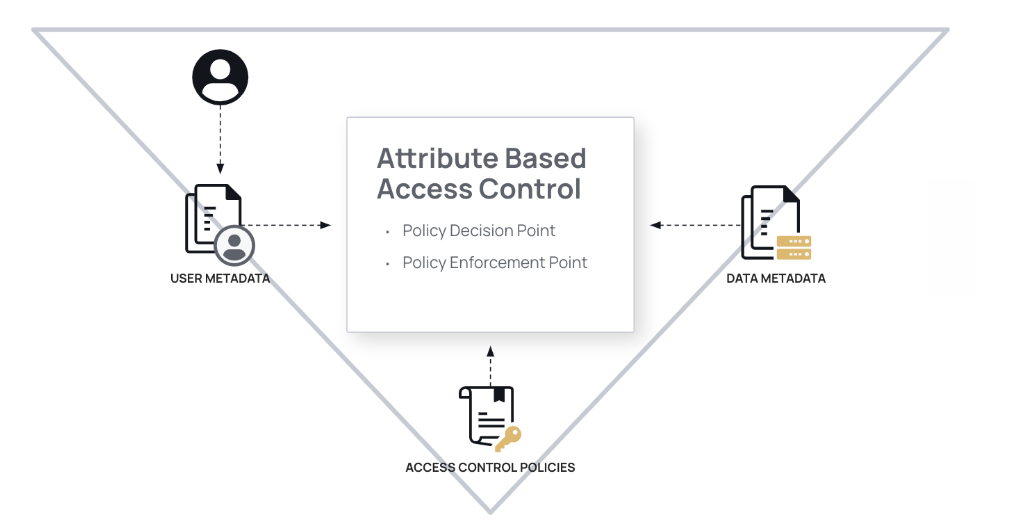
It’s important to understand that you only need a starting point to begin onboarding data access control use cases - you do not have to have every user perfectly associated with metadata for all use cases, nor do you need all data tagged perfectly for all use cases. Start small on a focused access control use case, and grow from there.
The policy authoring approaches are broken into the two paths you should choose between discussed previously.
Path 1: Orchestrated RBAC policy authoring
With orchestrated RBAC you have established one-to-one relationships with how your users are tagged (attribute or group) and what that single tag explicitly gives them access to. Remember, the user and data metadata should be facts and not reflect policy decisions veiled in a single fact; otherwise, you are setting yourself up for role explosion and should be using ABAC instead.
Since orchestrated RBAC is all about one-to-one matching of user metadata to data metadata, Immuta has special functions in our subscription policies for managing this:
@hasTagAsAttribute('Attribute Name', 'dataSource' | 'column')@hasTagAsGroup('dataSource' | 'column')
The first argument for @hasTagAsAttribute is the attribute key whose value tags will be matched against (or for @hasTagAsGroup simply the group name), and the second argument specifies whether the attribute values are matched against data source tags or column tags.
Understanding this, let’s use a simple example before we get into a hierarchical example. For this simple example, let’s say there are Strictly Confidential tables and Public Tables. Everyone has access to Public, and only special people have access to Strictly Confidential. Let’s also pretend there aren’t other decisions involved with someone getting access to Strictly Confidential (there probably is, but we’ll talk more about this in the ABAC path). It is just a single fact: you do or you don’t have that fact associated with you.
Then we could tag our users with their access under the Access attribute key:
- Bob:
Access: Strictly Confidential - Steve:
Access: Public
Then we could also tag our tables with the same metadata:
- Table 1:
Strictly Confidential - Table 2:
Public
Now we build a policy like so:

And ensure we target all tables with the policy in the builder:
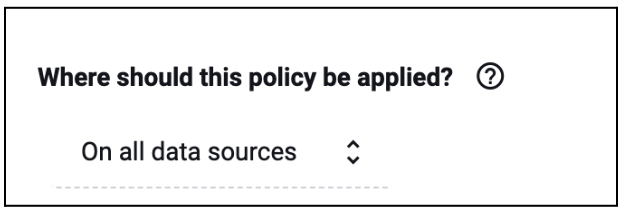
Here is the policy definition payload YAML for the above policy using the v2 api:
actions:
advanced: '@hasTagAsAttribute(''Access'', ''dataSource'')'
allowDiscovery: false
automaticSubscription: true
shareResponsibility: false
type: entitlements
name: Access
policyKey: Access
staged: false
template: false
type: subscription
Since this policy applies to all data sources, you only need a single policy in Immuta. When you change user metadata or data metadata, the access to those tables will automatically be updated by Immuta through the matching algorithm (user metadata matches the data metadata).
We could also use column tags instead, by tagging the columns appropriately:
- Table 1 --> Column 2:
Strictly Confidential
This tag change would require the following alteration to the function: @hasTagAsAttribute('Access', 'column') instead of @hasTagAsAttribute('Access', 'dataSource').
Finally, we could use groups instead of attributes:
- Bob:
Strictly Confidential - Steve:
Public
This change would require the following alteration to the function: @hasTagAsGroup('Access', 'column') instead of @hasTagAsAttribute('Access', 'column').
In the above case, we are using column tags again, but it could (and probably should) be data source tags. The reason is that orchestrated RBAC is not using facts about what is in your data source (the table) to determine access. Instead, it's using the single variable as a tag, and because of that, the single variable is better represented as a table tag. This also reduces the amount of processing Immuta has to do behind the scenes.
We can get more complicated with a hierarchy as well, but the approach remains the same: you need a single policy and you use the hierarchy to solve who should gain access to what by moving from most restrictive to least restrictive in your hierarchy tree on both the users and data metadata:
Groups approach:
- Bob:
Strictly Confidential - Steve:
Strictly Confidential.Confidential.Internal.Public
In this case, Steve would only gain access to tables or tables with columns tagged Strictly Confidential.Confidential.Internal.Public, but Bob would have access to tables or tables with columns tagged Strictly Confidential, Strictly Confidential.Confidential, Strictly Confidential.Confidential.Internal, and Strictly Confidential.Confidential.Internal.Public.
Orchestrated RBAC one-to-one matching can be powerful, but can also be a slippery slope to role explosion. You can quickly fall into rolling-up many decisions into a single group or attribute tied to the user (like Strictly Confidential) instead of prescriptively describing the real root reason of why someone should have access to Strictly Confidential in your policy engine. This is the power behind ABAC, and using the ABAC method of access can give you ultimate scalability and evolvability of policy with ease.
Path 2: ABAC policy authoring
Let’s say that having access to Strictly Confidential data isn’t a single simple fact attached to a user like we described in the orchestrated RBAC section (it likely isn't). Instead, let’s try to boil down why you would give someone access to Strictly Confidential. Let’s say that to have access to Strictly Confidential, someone should be
- an employee (not contractor)
- in the US
- part of the Legal team
Those are clearly facts about users, more so than Strictly Confidential. If you can get to the root of the question like this, you should, because Immuta allows you to pull in that information about users to drive policy.
Why should you bother getting to the root?
Well, consider what we just learned about how to author policy with orchestrated RBAC above. Now let’s say your organization changes their mind and now wants the policy for access to Strictly Confidential to be this:
- be an employee (not contractor)
- be in the US or France
- be part of the Legal team
With orchestrated RBAC this would be a nightmare, unless you already have a process to handle it. You would have to manually figure out all the users that meet that new criteria (in France) and update them in and out of Strictly Confidential. This is why orchestrated RBAC should always use a single fact that gains a user access.
However, if you are on the ABAC path, it’s a single simple policy logic change because of our powerful triangle that decouples policy logic from user and metadata attributes.
Let’s walk through an example:
The best approach is to build individual policies for each segment of logic associated with why someone should have access to Strictly Confidential information. Coming back to the original logic above, that would mean 3 (much more understandable) separate policies:
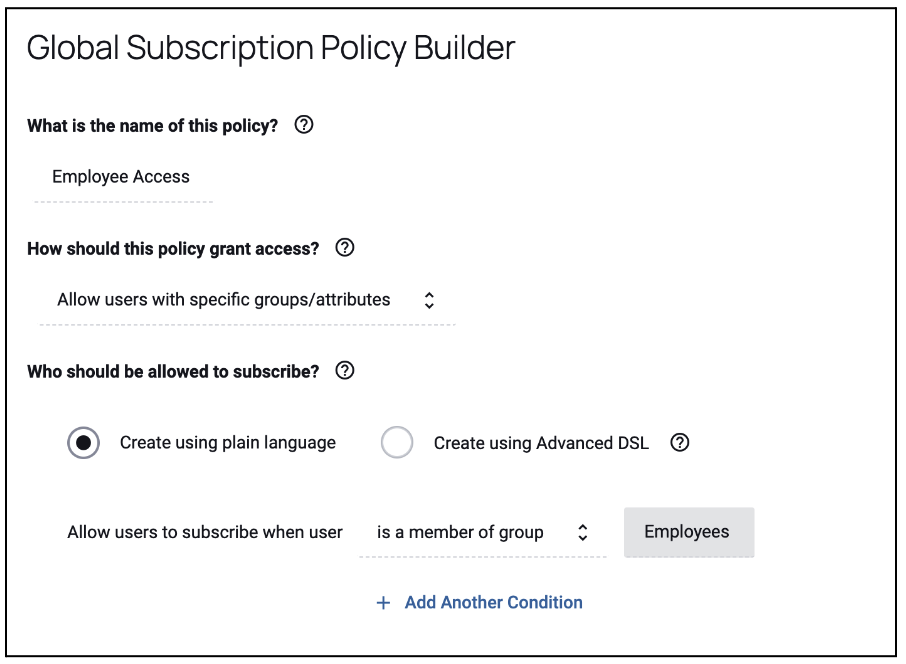
Here is the policy definition payload YAML for the above policy using the v2 api:
actions:
allowDiscovery: false
automaticSubscription: true
entitlements:
groups:
- Employees
operator: all
shareResponsibility: false
type: entitlements
circumstanceOperator: any
circumstances:
- columnTag: Strictly Confidential
type: columnTags
name: Employee Access
policyKey: Employee Access
staged: false
template: false
type: subscription
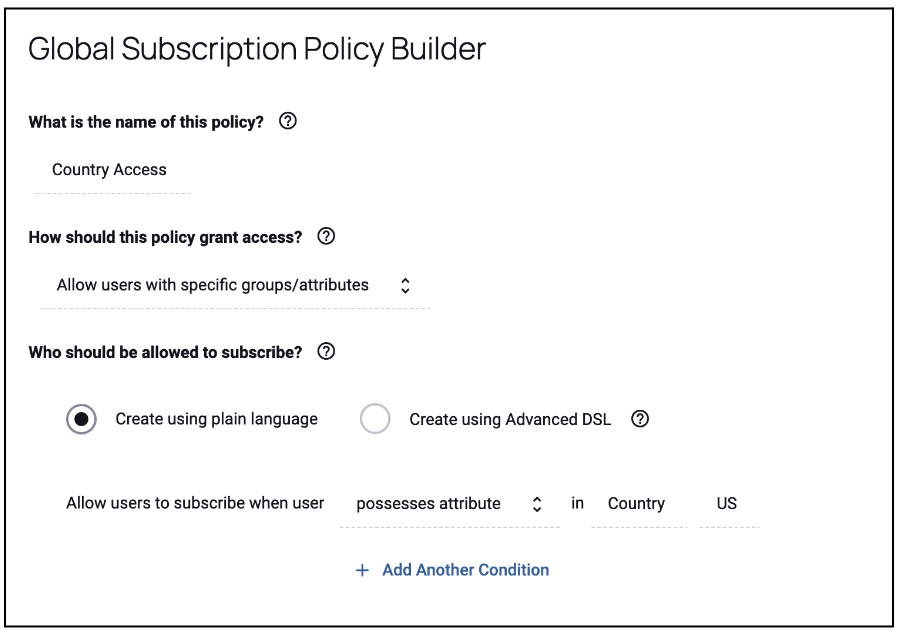
Here is the policy definition payload YAML for the above policy using the v2 api:
actions:
allowDiscovery: false
automaticSubscription: true
entitlements:
attributes:
- name: Country
value: US
operator: all
shareResponsibility: false
type: entitlements
circumstanceOperator: any
circumstances:
- columnTag: Strictly Confidential
type: columnTags
name: Country Access
policyKey: Country Access
staged: false
template: false
type: subscription

Here is the policy definition payload YAML for the above policy using the v2 api:
actions:
allowDiscovery: false
automaticSubscription: true
entitlements:
groups:
- Legal Team
operator: all
shareResponsibility: false
type: entitlements
circumstanceOperator: any
circumstances:
- columnTag: Strictly Confidential
type: columnTags
name: Legal Team Accesss
policyKey: Legal Team Accesss
staged: false
template: false
type: subscription
Each policy targets tables tagged Strictly Confidential (they could alternatively target columns tagged that):

When each of those policies converge on a single table tagged Strictly Confidential, they will be merged together appropriately by Immuta, demonstrating Immuta's conflict resolution:
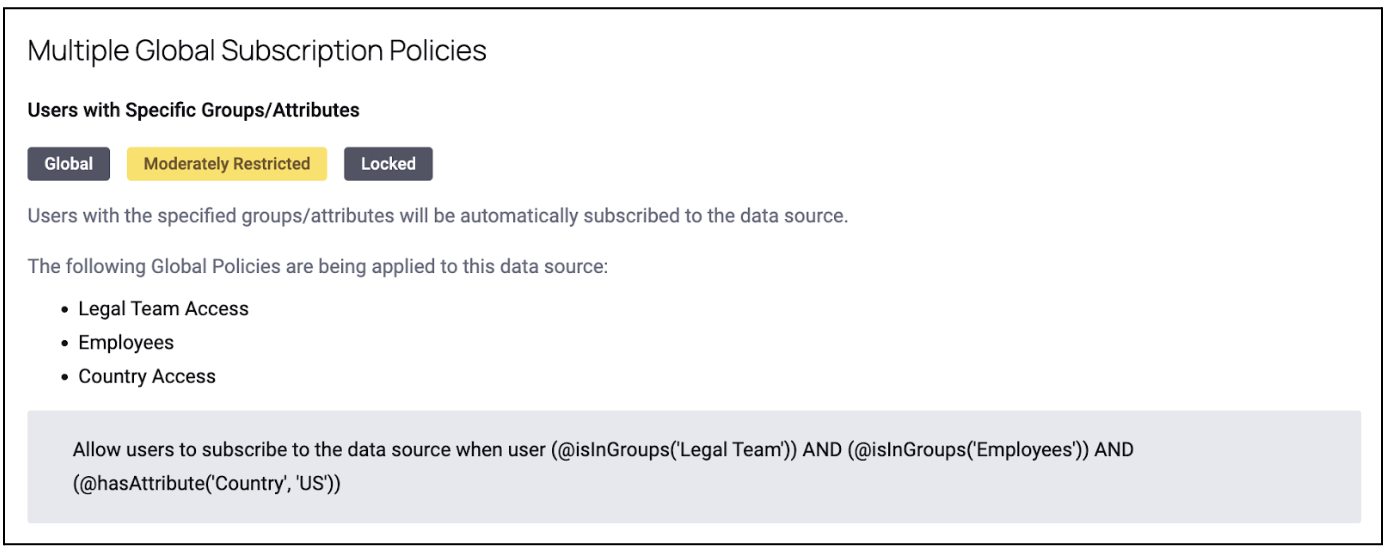
And whether merged with an AND or an OR is prescribed by this setting in the policy builder for each of the 3 individual policies:
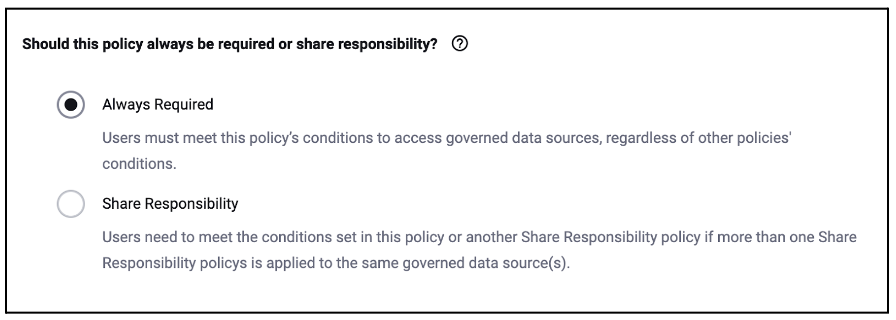
If either side of the policies are Always Required that will result in an AND; otherwise, if both sides agree to Share Responsibility it will result in an OR. In this case, each of the 3 policies chose Always Required, which is why the three policies were AND’ed together on merge. Note this merging behavior is relevant to how you can have different users manage policies without risk of conflicts.
Now let’s move into our nightmare (without Immuta) scenario where the business has changed the definition of who should have access to Strictly Confidential data by adding France along with the other existing three requirements.
With Immuta, all you’ve got to do is change that single Country Access subscription policy to include France, and voila, you’re done:
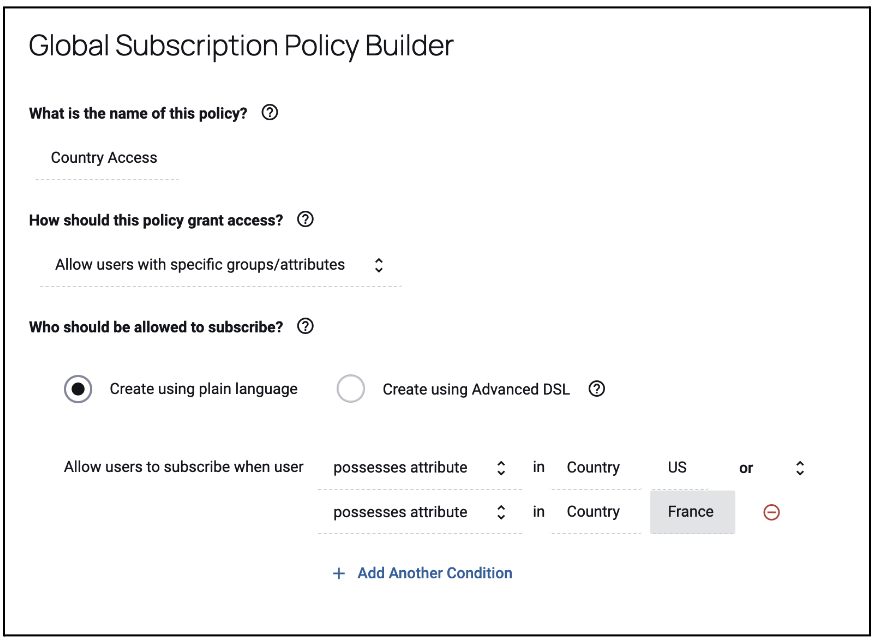
Here is the policy definition payload YAML for the above policy using the v2 api:
actions:
allowDiscovery: false
automaticSubscription: true
entitlements:
attributes:
- name: Country
value: US
- name: Country
value: France
operator: any
shareResponsibility: false
type: entitlements
circumstanceOperator: any
circumstances:
- columnTag: Strictly Confidential
type: columnTags
name: Country Access Two
policyKey: Country Access
staged: false
template: false
type: subscription
Which results in this merged policy on all the Strictly Confidential tagged tables:
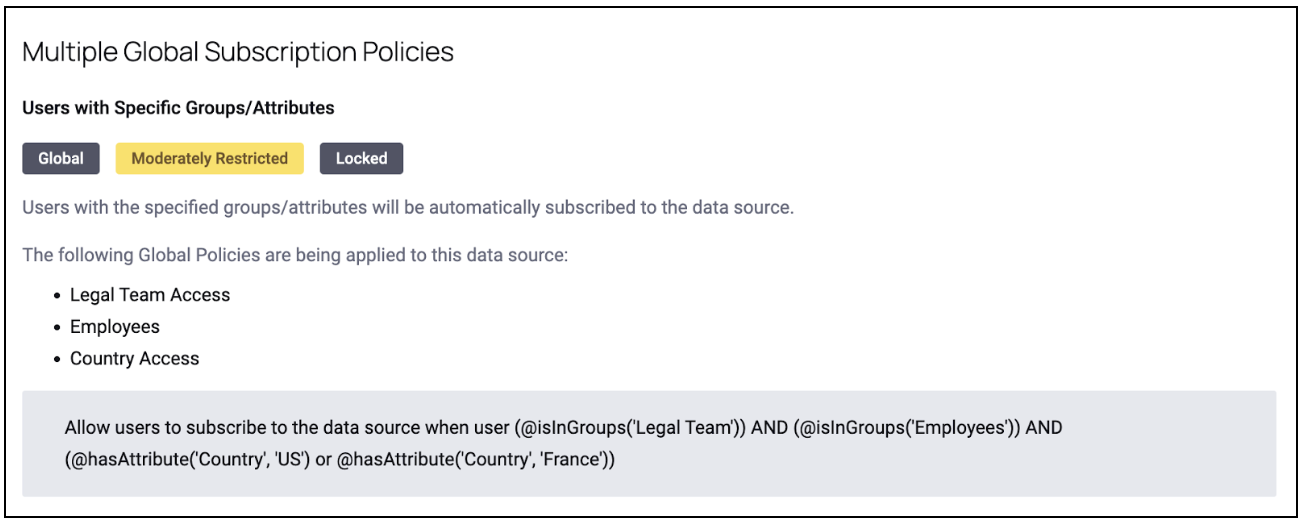
As you can see, ABAC is much more scalable and evolvable. Policy management becomes a breeze if you are able to capture facts about your users and facts about your data, and decouple policy decisions from it.
Also be aware, this auto-merging logic Immuta provides enables you to also combine orchestrated RBAC and ABAC policies.
Manual overrides
Last but not least are manual overrides. While this use case is all about automating access decisions, there may be cases where you want to give a user access even if they don’t meet the automated criteria.
This is possible through this setting in each policy:
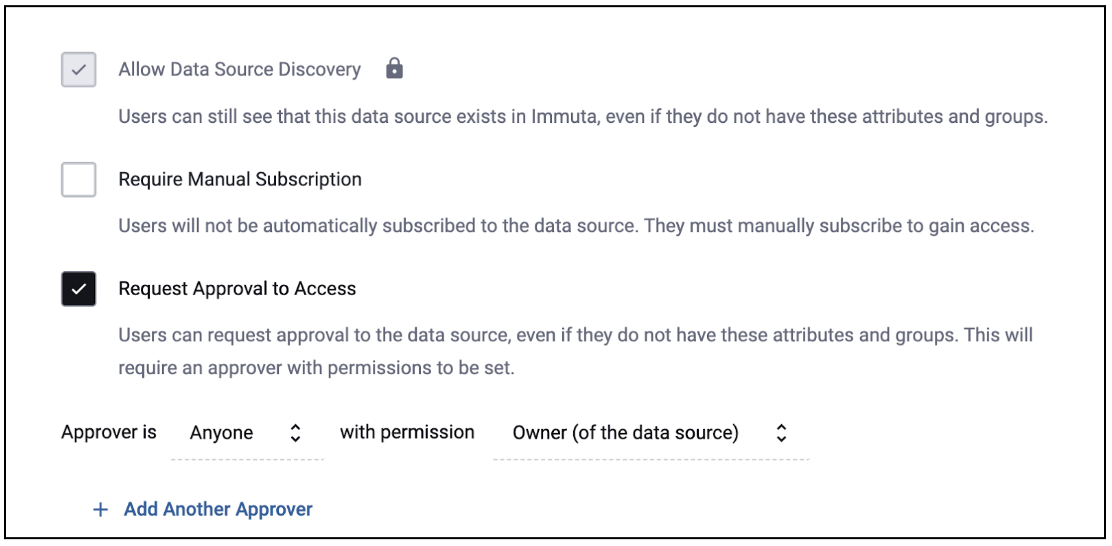
In this scenario, users marked as Owner of the registered data source in Immuta have the power to approve this override request by the user. There are ways to specify different approvers as well, or multiple approvers.
Also notice the grayed out Allow Data Source Discovery: normally, if you do not meet the criteria of a policy, the data source is not even visible to you in the Immuta UI or the data platform. However, if you have this checked, it is visible in the Immuta UI even if you don’t meet the policy. This must be checked in order to request approval to access. Otherwise, users would never find the data source to ask for approval in the Immuta UI.
Be aware that all policies that land on the table must have this same setting turned on in order to allow the manual override.